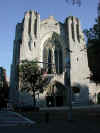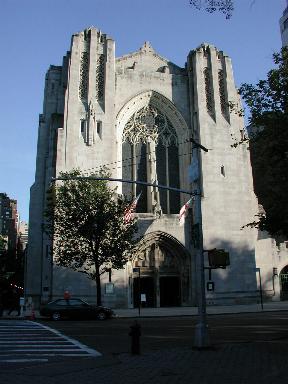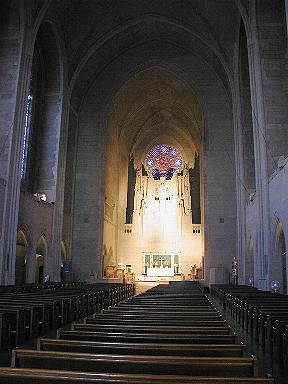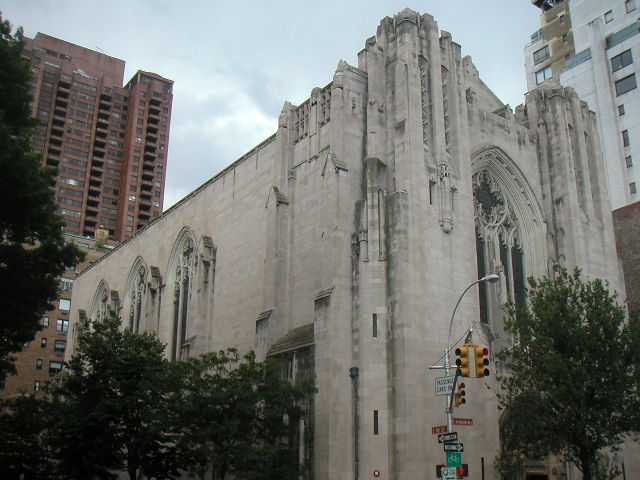 |
New York
Architecture Images-Upper East Side Church of the Heavenly Rest (Episcopal) |
|
architect |
Bertram Goodhue |
|
location |
Fifth Avenue & E 90th Street |
|
date |
1926 |
|
style |
Neo-Gothic. Art Deco |
|
construction |
limestone |
|
type |
Church |
|
images |
  |
 |
|
|
|
Special thanks
to www.churchcrawler.co.uk
(British and international church architecture site) for generous
permission to use images and info. |
|
The church has always stood on Fifth Avenue,
but originally much further south on E45th Street intersection. It was
founded by a group of Civil War veterans in 1865. The present site on the eastern side of Central Park was acquired from Mrs Andrew Carnegie. The foundation stone was laid in 1926 and the church held its first service in 1929. The architect was Bertram Goodhue but he had died in 1924 so his plans were executed by Hardie Phillip (of Mayers, Murray & Phillip). It is a modernised Gothic style, almost Art Deco in some features, with a shimmering facade of limestone with large Geometric four light window above a double portal. Flanking this are two turrets, like miniature towers. The doors lead into a vestibule under the west gallery, and this opens with three arches into the nave proper. The aisles are passages between the internal buttresses which rise with arches to near-full height, the spaces between with two low arches to a triforium above and tall side windows. The latter are filled with stained glass made by the English firm of Powells, to the designs of J.H.Hogan. The nave is very wide and has a vault, suspended from a steel framing. To the south of the nave is a side chapel, dedicated to The Beloved Disciple, recalling the church which was closed when this church was built and is now the RC church of St Thomas More (see below). The chancel is narrower and a little lower and also is vaulted. The east wall has a very large reredos (designed by Earl N.Thorp) above which a rose window completes the design. The glass here came from Scotland and was designed by J.Gordon Guthrie. |
|
|
|
|
|
Streetscapes/Church of the Heavenly Rest, Fifth Avenue and 90th
Street; Restoring One of Manhattan's Magnificent Churches By CHRISTOPHER GRAY Published: October 12, 1997 Copyright NYT IN 1991 the vestry of the Church of the Heavenly Rest, at 90th Street and Fifth Avenue, told the architects Gerald Allen and Jeffrey Harbinson to plan for a restoration that would take 20 years -- or longer. The designers were not disappointed. ''You have a lot of time to think about it,'' Mr. Allen said. Now the church's newly refinished doors and intricate hardware, with a surprising silver and bright red finish, are drawing stares from passersby. It is the latest episode in the ongoing connoisseur-quality restoration of one of Manhattan's most magnificent and inventive churches. The southeast corner of 90th and Fifth was vacant in 1901 when Andrew Carnegie built his blocklong mansion, now the Cooper-Hewitt Museum, just to the north. Carnegie, who became rich from steel and railroads, also bought the vacant land on the north side of 91st Street to protect his own site. But the property on the south corner of 90th Street remained undeveloped, covered with billboards and a ramshackle lemonade stand. Carnegie must have given frequent thought to that corner, and in 1917 he paid over $1.7 million for it -- just after a sign was posted that read ''For sale -- without restrictions.'' He might have been thinking of Henry Phipps, who had a big mansion at 87th and Fifth, declined to buy the empty land to the north -- and was then unpleasantly surprised when the apartment house at 1067 Fifth Avenue went up next door in 1915. Carnegie had no clear plan for the corner -- he just didn't want a tall building blocking his light, with residents peering down into his garden. He died in 1919, and in 1923 his widow, Louise, planned a group of 11 co-op town houses for the site but did not go ahead. In 1926, the Episcopal Church of the Heavenly Rest, then at Fifth Avenue and 45th Street, came shopping for a new site. Mrs. Carnegie sold the church the corner for $1 million, with restrictions through 1975 that the land be used only for a Christian church no higher than 75 feet, exclusive of steeples. The church hired the architects Mayers, Murray & Phillip, successors to Bertram Goodhue, one of America's most sensitive and influential designers, who designed St. Bartholomew's Church on Fifth Avenue and who died in 1924. They developed a design for a giant limestone mass in the neo-Gothic style, with bursts of sculpture by Malvina Hoffman, Lee Lawrie and other artists. The church opened in 1929 at a final cost of $3.2 million, seating 1,050, with the twin innovations of a sound system and indirect lighting. On the inside, the architects gave every pew an unobstructed view of the altar. The resulting wide span, and the high, nearly plain stone walls, produce a vast nave. George Chappell, the architecture critic for The New Yorker at the time, admired the gold stars and gold ribbing on the ceiling and praised the clever use of mortar joints to add to the sense of soaring height -- the joints are wide on the flagstones on the floor, medium on the walls and small on the vaulted ceiling, making it appear even farther away than it is. The finishes marry modern materials with delicate artistry. The glazed screen behind the entry doors is a dramatic work in Monel metal with gilded steel. The door hardware, of nickeled steel with Chinese red highlights, is astonishing. Every detail in the church came from the designer's hand -- nothing was a formula, or left to chance. Over two-thirds of the ambitious sculpture program was never executed. In 1928 the artist Janet Scudder said she withdrew from a commission for a life-size ''Madonna and Child'' because the church had reduced it from 5-feet-4 to 4-feet-7. In reply, Dr. Henry Darlington, the rector, said: ''Did you ever have anything to do with artists? One day she wanted the statue one size, and the next day she wanted it another.'' The stock market crash of October 1929 was probably the chief obstacle to completion, and the streamlined blocky forms that were meant to be carved give the church an abstract, modernistic quality that many have admired. The inside strikes some churchgoers as cold, especially those who expect a church with lots of paneling and hangings. But the smooth, uncompromising masonry of the Church of the Heavenly Rest, especially after a recent cleaning, is as majestic as a 1930's dam. THE church now has a congregation of 647 households, and has spawned several well-known organizations, including the Canterbury Choral Society, the York Theater Company and what is now called The Day School, a coeducational private school at the church. When Mr. Allen and Mr. Harbinson were hired in 1991, the plan was for a long-term renovation that included fixing leaks and electrical and ventilation difficulties as well as space problems. The scope was enlarged in August 1993 after a fire consumed the organ and choir area and blackened the interior. The flames popped off great chunks of stone from the arches; these have not yet been replaced and still offer a dramatic view as striking as the interior itself. Now, six years into the restoration program, Mr. Allen says the church has spent about $6 million and has nearly caught up with decades of deferred maintenance. His firm's work has been a delicate balance of understanding the original design but creating a new one where necessary, all with the luxury of time to consider and change opinions. The architects took five years to consider a new placement for the altar, and they are still considering the relocation of the Monel screen at the front. Coming in the next few months are new choir stalls of oak with trim, and candlesticks of polished and gilded steel in verdigris with silver highlights. Other plans include installing new chancel lighting to let the rose window float in the shadows, and removing the plastic sheets -- which mask the delicate stone tracery -- from the stained glass windows on the outside. More complicated is a proposal for 16 hanging lanterns in the nave, which could either compromise or emphasize the majesty of the space. Mixed in with these are practical things like mechanical systems and masonry work. Mr. Allen says the church is about two-thirds finished with its sanctuary, and one-third finished with its extensive support spaces. The typical New York City restoration proceeds all at once in a hurried manner, without much contemplation. This renovation is a gentle, reflective evolution. |
|
|
links |
http://www.heavenlyrest.org/ |